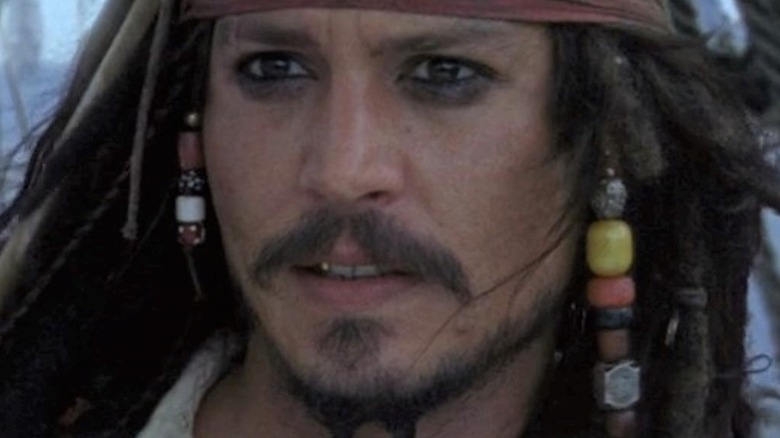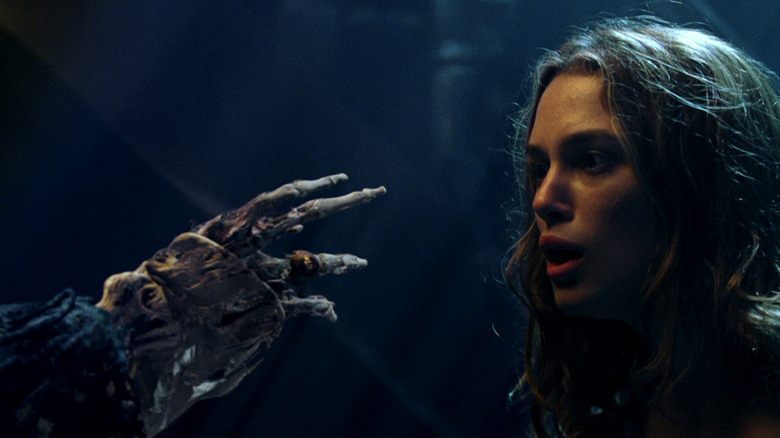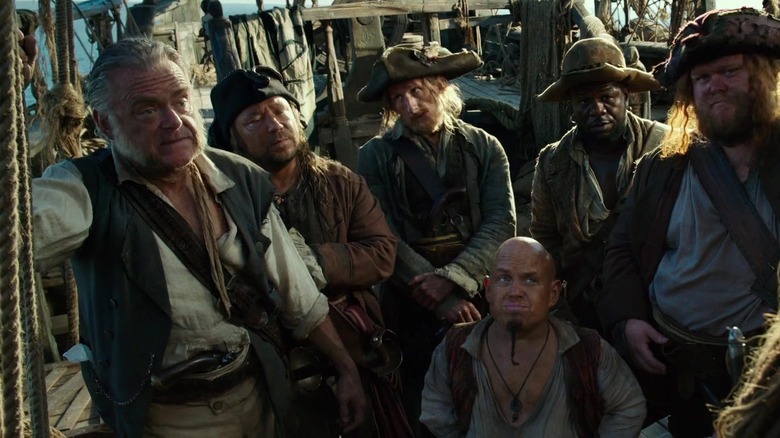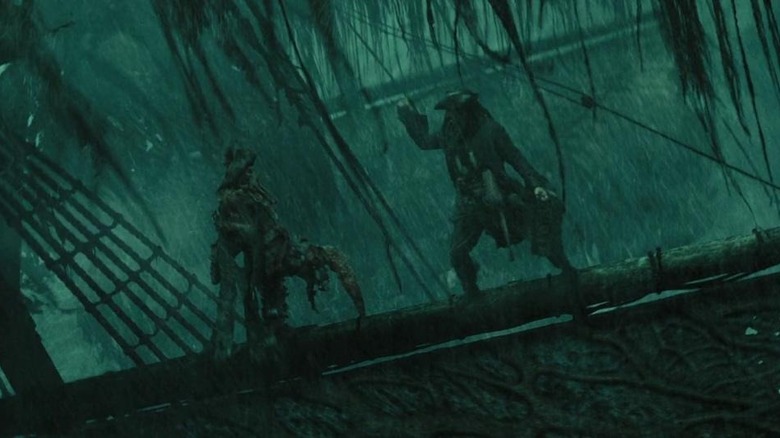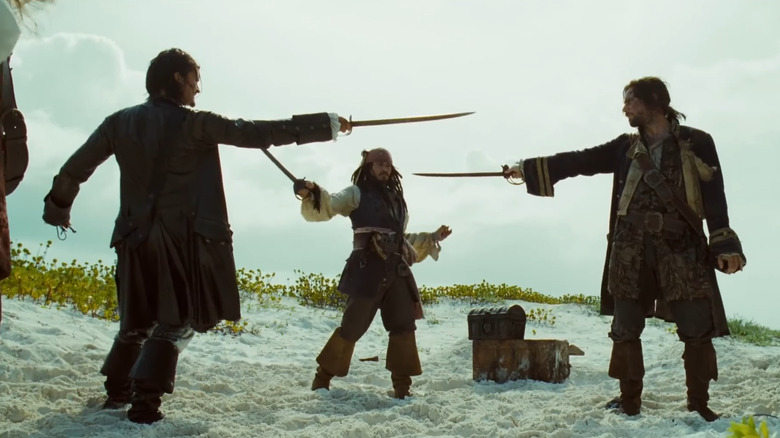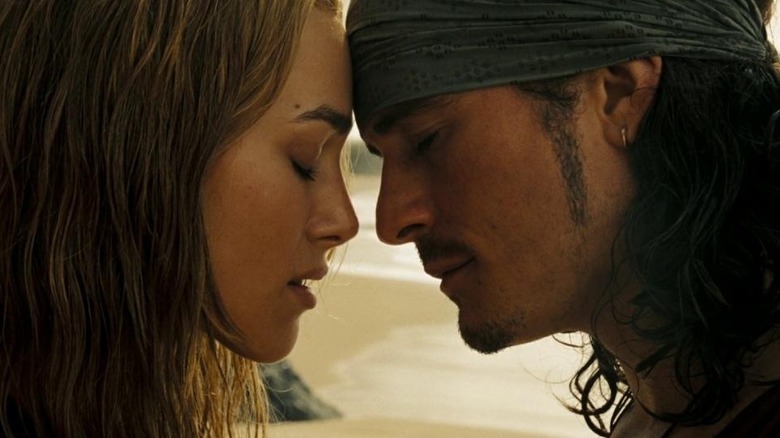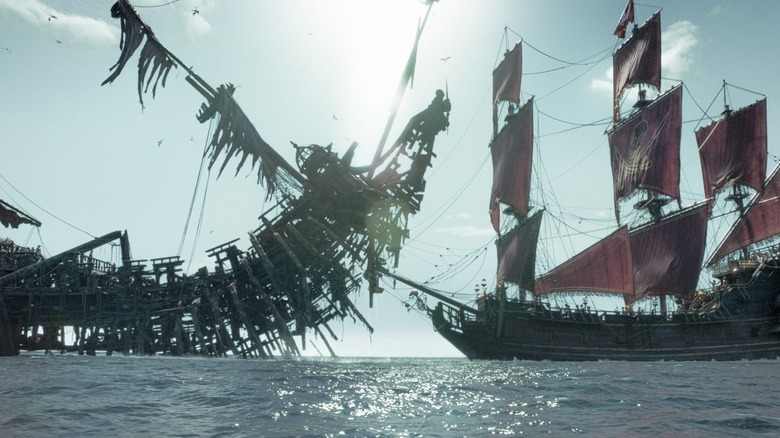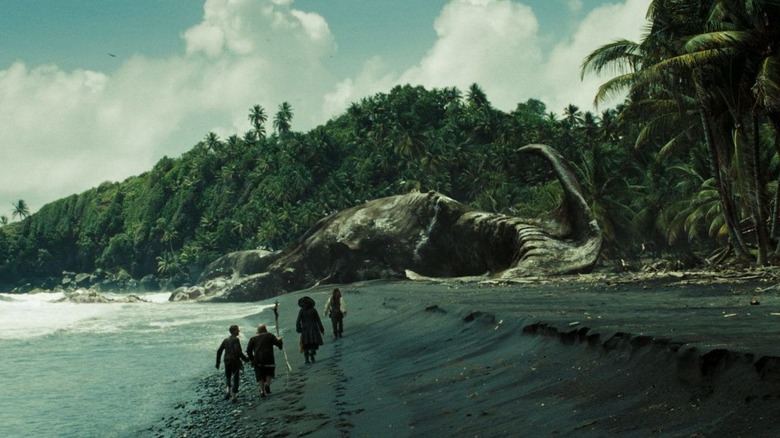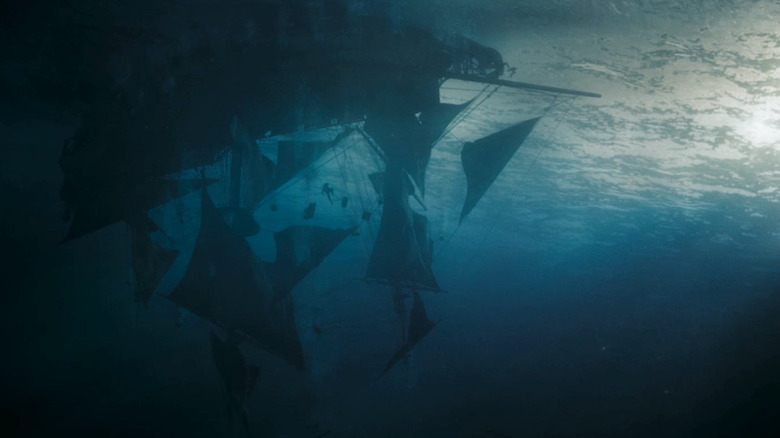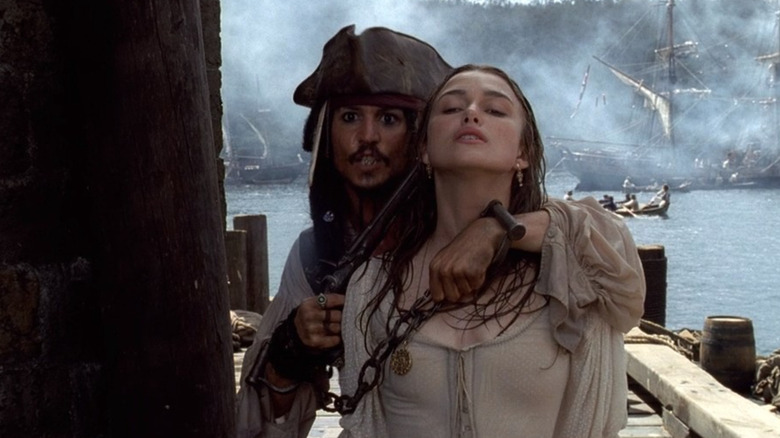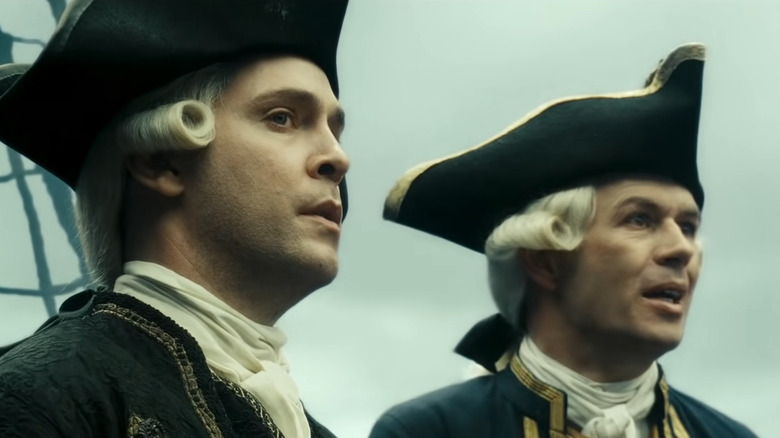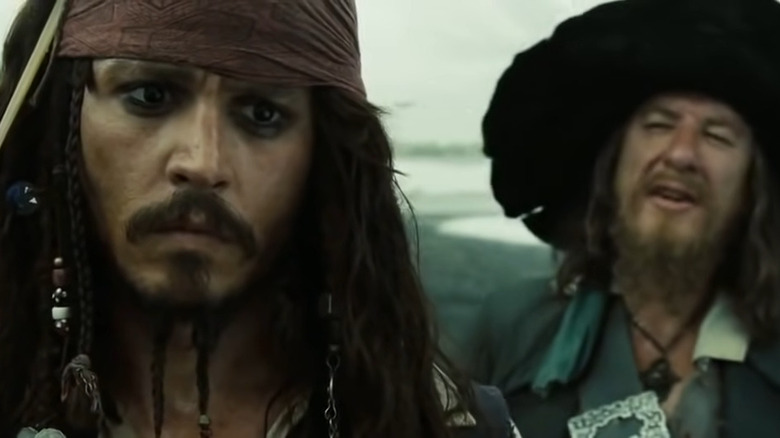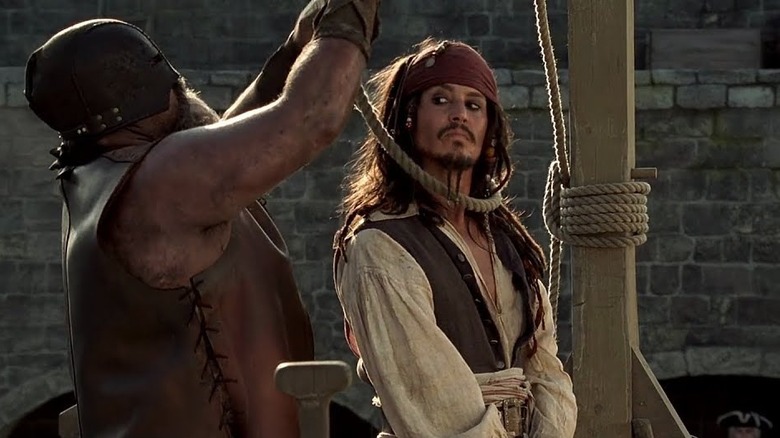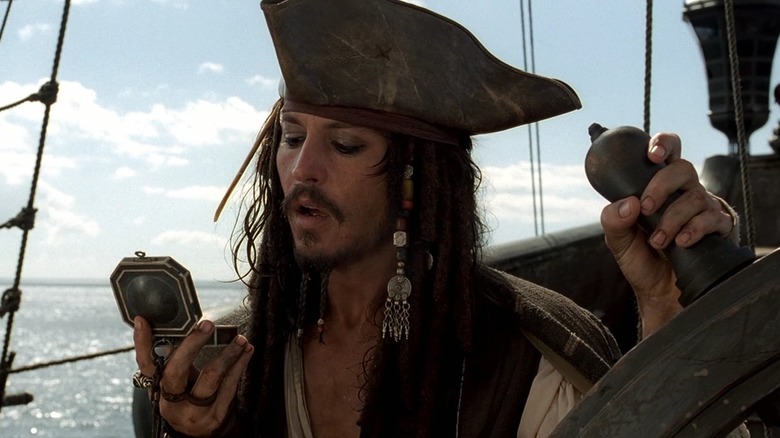Things That Happen In Every Pirates Of The Caribbean Movie
It can be hard to believe now, but there was a time when pirate-themed movies were considered a death knell at the box office. But that perception changed overnight with the breakout success of 2003's "Pirates of the Caribbean: The Curse of the Black Pearl," based on a Disney theme park ride.
The movie, considered one of the best pirate films ever made, starred Orlando Bloom and Keira Knightley as star-crossed lovers in the 1700s fighting to be with each other. But the standout performance was of course turned in by Johnny Depp in his immortal role as the rascally pirate Captain Jack Sparrow. "The Curse of the Black Pearl" spawned two direct sequels, and the character of Jack Sparrow became so popular that he took over as the main lead and face of the franchise after that.
To date, five movies have been made in the "Pirates of the Caribbean" series, and each film deals with a fantasy plot involving pirates and the British navy and mythical curses and beasts. And each movie in the franchise covers certain beats that audiences have grown very familiar with. Let us take a look at some of the things that you can be sure to expect in a "Pirates of the Caribbean" movie.
A sea-based curse
The events of every "Pirates of the Caribbean" movie are kickstarted due to the main characters' involvement in some ancient sea curse that threatens their lives. In "The Curse of the Black Pearl," a curse related to pirate treasure has Captain Barbossa's men gunning for Will Turner and Elizabeth Swann. And in the second movie, "Dead Man's Chest," Jack Sparrow receives a cursed black mark on his hand, symbolizing his unpaid debt to the villainous Davy Jones.
"At World's End" reveals that Davy Jones himself suffers a cursed life as the captain of the Flying Dutchman, a bit of maritime magic that eventually transfers to Will. In the fourth movie, "On Stranger Tides," it's the villainous Blackbeard who's cursed to lose his life as foretold by a prophecy. It falls to Jack to work with Blackbeard's daughter, Angelica, to save her father by getting him to the fabled Fountain of Youth.
Finally, in the fifth "Pirates" movie, "Dead Men Tell No Tales," an entire ship full of cursed men led by Captain Salazar are looking for Jack to settle an old score. In other words, you can't watch a "Pirates of the Caribbean" movie without stumbling across some sort of spell.
Lots of pirate slang
One of the high points of the original "Pirates of the Caribbean" film was its witty dialogue, which managed to sound old-fashioned yet modern at the same time. The zingers flew fast, and the exchanges between characters were couched in nautical terms suitable to that era, which viewers could still manage to decipher. Later movies in the series suffered somewhat in the writing department, but the dialogue remained a highlight. And because the entire franchise deals with 17th-century pirates, you get to hear plenty of their lingo — or at least a modern interpretation of it.
For instance, Jack Sparrow likes to ask "savvy?" to make sure people understand his complicated thoughts that come out as scattered, rapid-fire speeches. Then there are the well-known phrases like "ahoy," "all hands on deck," and "aye aye," all of which you get to hear at least once in each movie in the series. Some more obscure pirate terms are also called into play like "parley," and honestly, you could spend an entire movie watching Jack and Barbossa swapping old war stories from their pirating days with those old-school terms and phrases.
Jack does an impossible stunt
"Pirates of the Caribbean: The Curse of the Black Pearl" was based on a Disney theme park ride, and making a movie out of a theme park attraction is a complicated process. But one thing the filmmakers did right was giving audiences the kind of thrill you experience in a ride via preposterous stunts and near-escapes.
It usually falls to Jack Sparrow to pull those stunts off, which never have any basis in reality but look cool as heck on the big screen. For example, there's the scene in the first movie when Jack escapes a contingent of soldiers by using ropes, pulleys, and a cannon. Then there's the moment in the second film when Jack, Will Turner, and James Norrington are having a swordfight inside a giant wheel.
Over the franchise, the fights and escapes Jack get himself into get increasingly bigger and more wonderfully ludicrous. There's the moment where he's fighting on top of two ships locked together, circling a giant whirlpool. Or there's the scene he's escaping from a bank with a giant iron chest by dragging it behind his ship. While the action itself is completely impossible under real-world physics, these moments are pulled off so entertainingly that you can't help but be riveted while watching.
Sword fights with little blood
The biggest trick that the "Pirates of the Caribbean" movies pull off is convincing global audiences that pirates were good-natured scallywags who occasionally stole from the rich and thumbed their noses at authority figures. This, of course, is not how real-world extremely violent and bloodthirsty pirates operated.
But reality doesn't matter when you have to get that PG-13 rating for your movie to ensure as many people are allowed to see it as possible. And so the violence in the "Pirates of the Caribbean" franchise consists of flashy sword fights and occasional gunshots but very little actual blood.
In fact, it's remarkable how often Jack Sparrow finds himself in the middle of fights or chases that would maim or kill a lesser person, and yet Jack always walks away from the whole thing without a scratch on his body. You are much more likely to see characters who've been in a fight covered in mud than in blood. But thanks to how well-choreographed the action sequences are, audiences are usually too busy enjoying a lively sword fight scene to wonder about the lack of actual bodily injuries.
A central love story
Despite featuring plenty of action and adventure, the first "Pirates of the Caribbean" movie is at its heart a romance about doomed lovers. Will Turner and Elizabeth Swann come from different societal classes, which doesn't permit them to express their love for each other. It takes Elizabeth's kidnapping by Barbossa to finally make Will reveal his true feelings and set off on a quest to rescue her.
All the other movies in the series remember to continue with the theme of young lovers kept apart by cruel fate. Elizabeth and Will's love story is explored with the next two movies, "Dead Man's Chest" and "At World's End," even though things don't end very happily for them. After that, "On Stranger Tides" has a captive priest falling in love with a mermaid.
Then comes "Dead Men Tell No Tales." This time, the young male lover is none other than Henry Turner, the son of William and Elizabeth Turner, who seeks a way to reunite his parents using the Trident of Poseidon. During his quest, Henry falls in love with Carina, the secret daughter of Barbossa. In other words, while Jack Sparrow's antics and the fun swordfights draw viewers in, it's the young love that keeps them glued to the screen.
A pirate ship that defies all physics
The "Pirates of the Caribbean" franchise takes place in a world of magical realism where black magic exists and the seas are run by mysterious forces that can bring people back from the dead and spawn impossibly mighty and terrible creatures. The ships of the series adhere to this reality by doing things no ordinary boats can.
Let us start with the Black Pearl, the most important ship in the saga and the one that kickstarts the entire franchise. In the beginning, the Pearl is considered a "ghost ship" of sorts, laden with undead pirates, whose arrival always spell doom. After Jack Sparrow succeeds in reclaiming the captaincy of the Pearl, an ever bigger threat arrives in the form of the Flying Dutchman, which can travel underwater and summon a massive kraken.
Then comes Blackbeard's personal ship, which can control the very elements of wind and water and houses many other ships in miniature form. Finally, there's Captain Salazar's ship, which acts like a mechanical monster, capable of unhinging its bow like wooden jaws to chomp into and destroy other ships. Honestly, at this point, the franchise is one step away from turning its ships into sea-faring Transformers.
So much alcohol consumption
Even though the "Pirates of the Caribbean" franchise is all about the titular buccaneers, there's only so much piratey stuff you can show the characters participating in when the movie is made by Disney with a PG-13 rating. In lieu of depicting the main cast of pirates looting and burning and terrorizing the seas, we get to see them drinking lots and lots and lots of bootlegged alcohol.
The concept is so important to the series that a major plot point in "The Curse of the Black Pearl" deals with how Jack Sparrow had survived being marooned on a desert island by drinking himself into a stupor for the duration of his stay. In fact, Johnny Depp portrays Sparrow as being constantly tipsy and searching for something new to drink, an acting choice that the producers of the movie had a hard time getting on board with. Of course, over the series, many of the major characters have been seen in a state of severe intoxication, from the formerly upstanding James Norrington who falls on hard days and takes to drowning his sorrows to Elizabeth Swann asserting her independence to Jack's second-in-command Gibbs, who never turns a bottle down on principle.
If you or anyone you know is struggling with addiction issues, help is available. Visit the Substance Abuse and Mental Health Services Administration website or contact SAMHSA's National Helpline at 1-800-662-HELP (4357).
Lots of mythological creatures
Despite being a rare series that doesn't draw on any pre-existing materials like novels or comic books, the reason the "Pirates of the Caribbean" franchise feels so familiar is because it draws liberally from world mythology pertaining to the seas, skillfully changing and retro-fitting parts of the mythologies for the sake of its narrative.
"The Curse of the Black Pearl" takes baby steps in this direction with the main plot revolving around a classic "ghost ship" full of undead pirates. After the film became wildly successful, the makers doubled down on the idea, introducing the mighty kraken as a massive beast capable of destroying any ship in a matter of seconds. And there's also the legendary Flying Dutchman with a re-imagined Davy Jones.
With "On Stranger Tides," the story moves on to the legends of mermaids and the Fountain of Youth, not to mention Blackbeard, the most well-established pirate in pop culture (at least until Jack Sparrow came along). Finally there's "Dead Men Tell No Tales," which focuses on a dark secret lurking beneath the Bermuda Triangle and the mythical Trident of Poseidon that both the heroes and villains of the story are after.
Above water to underwater shot
Unless they're directed by James Cameron, there aren't a lot of modern-day movies that take place around water. Perhaps that's because water makes things difficult for filmmakers. Maybe that's because movies like "Master and Commander: The Far Side of the World" are often box office bombs. Whatever the reason, you don't get a lot of maritime movies ... unless Jack Sparrow is around.
This lack of aquatic competition has given the "Pirates of the Caribbean" franchise the chance to put its own signature on the vast sea, be it actual H2O or CGI. One way the series has capitalized on this is with the help of long, sweeping shots that take the camera from above the water directly underwater, making the two worlds part of the same narrative.
The most exciting shot in this regard is seen in "At World's End," when Jack Sparrow and the rest of the crew of the Black Pearl rock the ship from side to side until it turns completely upside down. Other movies in the series also make good use of the technique, like the shot near the end of "The Curse of the Black Pearl," where you see the enemy's ship floating above water, and in the next scene, you see an army of undead pirates marching on the seabed underneath the ship to chilling effect.
This is the day you almost caught Captain Jack Sparrow
While great care was accorded to most elements of the "Pirates of the Caribbean" movies, the one factor that stands head and shoulders above the rest is Johnny Depp's iconic take on Captain Jack Sparrow. Depp was so good at playing the role that Jack went from being a supporting character to becoming the face of the series.
A major reason behind Jack's popularity is how memorable his look and mannerisms are, from the kohl-lined eyes to the many chains and bangles to the drunken gait and the way of talking that oscillates between madness and genius. Everything about Jack is designed to draw the viewers in and hold their attention. And this includes giving the character a catchphrase that fans are always watching out for.
Whenever Jack is about to make one of his daring escapes from the authorities, he declares to his pursuers, "You will always remember this as the day you almost caught Captain Jack Sparrow." Sometimes Jack says the whole line. Other times he's interrupted in the middle of the quote. But that doesn't make the line any less badass when Jack swaggers away looking like the ultimate escape artist.
Pirates good, authorities bad
Since the franchise is called "Pirates of the Caribbean," the writers had to come up with a way to make their main characters into likeable people despite technically being outlaws. To that end Jack Sparrow, Barbossa, and their crew of pirates are less about looting and plundering and more about embarking on mystical treasure hunts.
In the first movie that treasure was a cursed gold coin. The next movie had Davy Jones' literal locker, and so on and so forth. In this capacity, the pirates of the series technically come across as the good guys. But you also need a good villain in an action-adventure series. That role is played pretty comprehensively by the ruling British elites, who oppose the plans of Sparrow and his allies.
Starting with naval officer James Norrington, then Lord Cutler Beckett of the East India Trading Company, then the king of England himself, the people in positions of actual power in the series are presented as the villains who want to exploit the resources of the oceans and curtail the freedoms of the free-spirited pirates. After all, it's way easier to root for a rum-swilling underdog than cheering for "the man."
Secret deals and double-crosses
Even though the swashbucklers shown in "Pirates of the Caribbean" films are depicted as good guys, they are still thieves and schemers looking to make a quick buck through any method possible. This means the movies feature lots and lots of secret deals and double-crosses to spice up the narrative.
Jack Sparrow is himself the most prominent example of the perennial schemer. A big part of his mystique in the first movie is the question of whose side he's really on and the fact that you can never be sure whether or not he'll betray Will and Elizabeth to Barbossa and James Norrington. This theme continues in the next two movies, with Elizabeth, Will, and Jack all betraying each other at various points.
The end of "On Stranger Tides" also has Jack turning on Blackbeard to save Angelica's life. But none of the double-crosses and secrets of the other characters compare to the torturous relationship between Jack and Barbossa. The two have spent their whole lives stabbing each other in the back, and you get to see that happen yet again in "Dead Men Tell No Tales" when Barbossa promises to help Salazar track down and take revenge on Jack.
Nearly getting executed
One way the "Pirates of the Caribbean" movies keep audiences engaged through their complicated twists and turns is with the ever-present threat of death hanging over the main characters. Aside from nearly getting blown up by gunpowder, shot down by pistols, or run through with swords, characters also have to regularly deal with getting sentenced to execution, usually by hanging.
The end of "The Curse of the Black Pearl" sees Jack wearing a noose around his neck, seconds away from being hanged until William steps in to help him escape. In the second film, it's Elizabeth who sentences Jack to death by leaving him chained to his ship, awaiting the arrival of the Kraken. "At World's End" kicks things up several notches by showing multiple men, women, and children getting hanged for piracy.
"On Stranger Tides" changes things up by having the hangings carried out by Blackbeard against Jack Sparrow and his entire crew, using the magical ropes of Blackbeard's ship. But the most preposterous execution scene occurs in "Dead Men Tell No Tales," where both Jack and Carina are seconds away from being guillotined and hanged, respectively, until their friends come to rescue them.
On to the next adventure
At the end of "Pirates of the Caribbean: The Curse of the Black Pearl," Jack Sparrow finds himself about to be hanged. Despite having lost the opportunity to escape, Jack accepts his fate with a calm mind because he's fulfilled his oath to get revenge against Barbossa and his crew for taking the Black Pearl from him years ago.
If the movie had ended with Jack's execution, the climax would have been bittersweet but still a fitting end to Jack Sparrow's career. Instead, the writers decided to help Jack escape from certain death and embark on a fresh adventure in the next movie. This became a trend through all five "Pirates of the Caribbean" movies that have been made so far.
In each one, Jack comes close to losing either his life or his freedom, but ultimately, he manages to get away with both. And so you can always bet on the films in the franchise ending with the sight of Jack newly escaped and plotting his next grand adventure.
